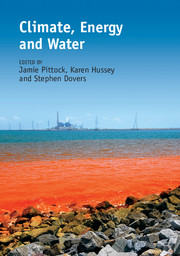Book contents
- Frontmatter
- Contents
- List of contributors
- Acknowledgements
- 1 Justifying, extending and applying “nexus” thinking in the quest for sustainable development
- 2 Water resources, climate change and energy
- 3 Implications of climate change for energy systems in a multisectoral context
- 4 Fossil fuels and water: A complex and evolving relationship
- 5 Renewable energy and water
- 6 Hydropower within the climate, energy and water nexus
- 7 Water and biofuels
- 8 Trade-offs and synergies between water and energy use in rural Australia
- 9 Management of the urban energy-water nexus
- 10 Managing the electricity-water nexus in China, France, India and the United States
- 11 Cross-sectoral governance of the climate, energy and water sectors: A ‘Rubik's cube’ analysis of cross-sectoral co-ordination
- 12 Regulation of the nexus
- 13 Climate, energy and water: the potential roles and limitations of markets
- 14 Strategies to mainstream climate change, energy, water and food security nexus knowledge and skills
- 15 A nexus of nexuses: systemic governance for climate response
- 16 Integrated modelling of the energy-water nexus in the American West
- 17 Biodiversity and the climate, energy and water nexus
- 18 Consumers, food supply chain and the nexus
- 19 Future prospects in climate, energy and water research and policy
- Index
10 - Managing the electricity-water nexus in China, France, India and the United States
Published online by Cambridge University Press: 05 April 2015
- Frontmatter
- Contents
- List of contributors
- Acknowledgements
- 1 Justifying, extending and applying “nexus” thinking in the quest for sustainable development
- 2 Water resources, climate change and energy
- 3 Implications of climate change for energy systems in a multisectoral context
- 4 Fossil fuels and water: A complex and evolving relationship
- 5 Renewable energy and water
- 6 Hydropower within the climate, energy and water nexus
- 7 Water and biofuels
- 8 Trade-offs and synergies between water and energy use in rural Australia
- 9 Management of the urban energy-water nexus
- 10 Managing the electricity-water nexus in China, France, India and the United States
- 11 Cross-sectoral governance of the climate, energy and water sectors: A ‘Rubik's cube’ analysis of cross-sectoral co-ordination
- 12 Regulation of the nexus
- 13 Climate, energy and water: the potential roles and limitations of markets
- 14 Strategies to mainstream climate change, energy, water and food security nexus knowledge and skills
- 15 A nexus of nexuses: systemic governance for climate response
- 16 Integrated modelling of the energy-water nexus in the American West
- 17 Biodiversity and the climate, energy and water nexus
- 18 Consumers, food supply chain and the nexus
- 19 Future prospects in climate, energy and water research and policy
- Index
Summary
Introduction
Existing and planned reliance on electricity supply – generally from thermoelectric power plants, facilities that combust fuels or fission atoms – depends too heavily on assumptions of widespread, abundant water resources. For instance, the International Energy Agency recently estimated that global water withdrawals – water utilised by power plants but returned to the original source – for the electricity sector amounted to 585 billion cubic meters in 2010 – about 15 per cent of the world total, or an amount greater than the annual average discharge of the Ganges River in India. During this year, the world's thermoelectric power plants also consumed – used up water that did not return to the local hydrological cycle – 66 billion cubic metres of water. By 2035, the International Energy Agency (2012, p. 514) projected that withdrawals will increase by 35 per cent (in the Current Policies Scenario) to 790 billion cubic metres and consumption will more than double to 130 billion cubic metres.
The availability of water and downstream impacts on its quality is therefore a salient energy security concern. Affirming this point, one broad-ranging survey of 2,167 energy users in ten countries, including the United States, Japan, China, India and Saudi Arabia, found that ‘enhancing the availability and quality of water’ was the highest rated energy security dimension among sixteen options (Sovacool et al. 2012). This meant respondents rated it more highly than security of supply of fossil fuels and uranium and responding to climate change, among others.
To illustrate this importance, this chapter depicts how water may become a key constraint to thermoelectric power generation in four case studies covering northern China, France, India, and a part of the United States, based on current projections of water and power demand through 2040. Each case reveals something different about the electricity-water nexus: China, the sheer quantity of water needed to meet future electricity (and industrial) demand; France, the water-related vulnerability of nuclear power units; India, the water vulnerabilities of coal-fired power; and Texas, the significance of wind energy and natural gas in enabling power providers there to generate electricity in times of drought while reducing water dependencies.
- Type
- Chapter
- Information
- Climate, Energy and Water , pp. 155 - 171Publisher: Cambridge University PressPrint publication year: 2015



